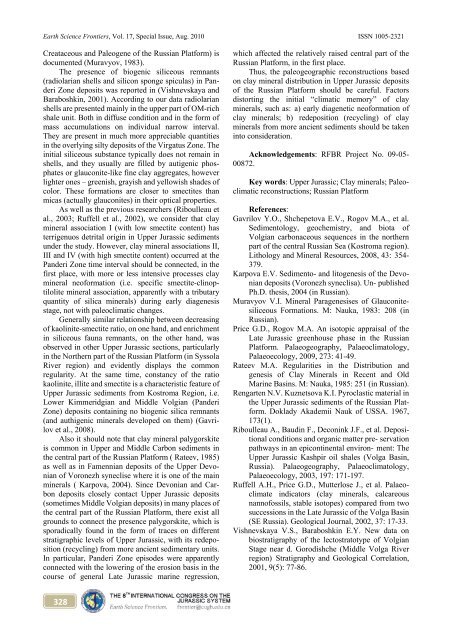in Jurassic and Cretaceous Stratigraphy
in Jurassic and Cretaceous Stratigraphy
in Jurassic and Cretaceous Stratigraphy
Create successful ePaper yourself
Turn your PDF publications into a flip-book with our unique Google optimized e-Paper software.
Earth Science Frontiers, Vol. 17, Special Issue, Aug. 2010 ISSN 1005-2321<br />
Creataceous <strong>and</strong> Paleogene of the Russian Platform) is<br />
documented (Muravyov, 1983).<br />
The presence of biogenic siliceous remnants<br />
(radiolarian shells <strong>and</strong> silicon sponge spiculas) <strong>in</strong> Pan-<br />
deri Zone deposits was reported <strong>in</strong> (Vishnevskaya <strong>and</strong><br />
Baraboshk<strong>in</strong>, 2001). Accord<strong>in</strong>g to our data radiolarian<br />
shells are presented ma<strong>in</strong>ly <strong>in</strong> the upper part of OM-rich<br />
shale unit. Both <strong>in</strong> diffuse condition <strong>and</strong> <strong>in</strong> the form of<br />
mass accumulations on <strong>in</strong>dividual narrow <strong>in</strong>terval.<br />
They are present <strong>in</strong> much more appreciable quantities<br />
<strong>in</strong> the overly<strong>in</strong>g silty deposits of the Virgatus Zone. The<br />
<strong>in</strong>itial siliceous substance typically does not rema<strong>in</strong> <strong>in</strong><br />
shells, <strong>and</strong> they usually are filled by autigenic phos-<br />
phates or glauconite-like f<strong>in</strong>e clay aggregates, however<br />
lighter ones – greenish, grayish <strong>and</strong> yellowish shades of<br />
color. These formations are closer to smectites than<br />
micas (actually glauconites) <strong>in</strong> their optical properties.<br />
As well as the previous researchers (Riboulleau et<br />
al., 2003; Ruffell et al., 2002), we consider that clay<br />
m<strong>in</strong>eral association I (with low smectite content) has<br />
terrigenuos detrital orig<strong>in</strong> <strong>in</strong> Upper <strong>Jurassic</strong> sediments<br />
under the study. However, clay m<strong>in</strong>eral associations II,<br />
III <strong>and</strong> IV (with high smectite content) occurred at the<br />
P<strong>and</strong>eri Zone time <strong>in</strong>terval should be connected, <strong>in</strong> the<br />
first place, with more or less <strong>in</strong>tensive processes clay<br />
m<strong>in</strong>eral neoformation (i.e. specific smectite-cl<strong>in</strong>op-<br />
tilolite m<strong>in</strong>eral association, apparently with a tributary<br />
quantity of silica m<strong>in</strong>erals) dur<strong>in</strong>g early diagenesis<br />
stage, not with paleoclimatic changes.<br />
Generally similar relationship between decreas<strong>in</strong>g<br />
of kaol<strong>in</strong>ite-smectite ratio, on one h<strong>and</strong>, <strong>and</strong> enrichment<br />
<strong>in</strong> siliceous fauna remnants, on the other h<strong>and</strong>, was<br />
observed <strong>in</strong> other Upper <strong>Jurassic</strong> sections, particularly<br />
<strong>in</strong> the Northern part of the Russian Platform (<strong>in</strong> Syssola<br />
River region) <strong>and</strong> evidently displays the common<br />
regularity. At the same time, constancy of the ratio<br />
kaol<strong>in</strong>ite, illite <strong>and</strong> smectite is a characteristic feature of<br />
Upper <strong>Jurassic</strong> sediments from Kostroma Region, i.e.<br />
Lower Kimmeridgian <strong>and</strong> Middle Volgian (P<strong>and</strong>eri<br />
Zone) deposits conta<strong>in</strong><strong>in</strong>g no biogenic silica remnants<br />
(<strong>and</strong> authigenic m<strong>in</strong>erals developed on them) (Gavri-<br />
lov et al., 2008).<br />
Also it should note that clay m<strong>in</strong>eral palygorskite<br />
is common <strong>in</strong> Upper <strong>and</strong> Middle Carbon sediments <strong>in</strong><br />
the central part of the Russian Platform ( Rateev, 1985)<br />
as well as <strong>in</strong> Famennian deposits of the Upper Devo-<br />
nian of Voronezh syneclise where it is one of the ma<strong>in</strong><br />
m<strong>in</strong>erals ( Karpova, 2004). S<strong>in</strong>ce Devonian <strong>and</strong> Car-<br />
bon deposits closely contact Upper <strong>Jurassic</strong> deposits<br />
(sometimes Middle Volgian deposits) <strong>in</strong> many places of<br />
the central part of the Russian Platform, there exist all<br />
grounds to connect the presence palygorskite, which is<br />
sporadically found <strong>in</strong> the form of traces on different<br />
stratigraphic levels of Upper <strong>Jurassic</strong>, with its redepo-<br />
sition (recycl<strong>in</strong>g) from more ancient sedimentary units.<br />
In particular, P<strong>and</strong>eri Zone episodes were apparently<br />
connected with the lower<strong>in</strong>g of the erosion basis <strong>in</strong> the<br />
course of general Late <strong>Jurassic</strong> mar<strong>in</strong>e regression,<br />
328<br />
which affected the relatively raised central part of the<br />
Russian Platform, <strong>in</strong> the first place.<br />
Thus, the paleogeographic reconstructions based<br />
on clay m<strong>in</strong>eral distribution <strong>in</strong> Upper <strong>Jurassic</strong> deposits<br />
of the Russian Platform should be careful. Factors<br />
distort<strong>in</strong>g the <strong>in</strong>itial “climatic memory” of clay<br />
m<strong>in</strong>erals, such as: a) early diagenetic neoformation of<br />
clay m<strong>in</strong>erals; b) redeposition (recycl<strong>in</strong>g) of clay<br />
m<strong>in</strong>erals from more ancient sediments should be taken<br />
<strong>in</strong>to consideration.<br />
Acknowledgements: RFBR Project No. 09-05-<br />
00872.<br />
Key words: Upper <strong>Jurassic</strong>; Clay m<strong>in</strong>erals; Рaleo-<br />
climatic reconstructions; Russian Platform<br />
References:<br />
Gavrilov Y.O., Shchepetova E.V., Rogov M.A., et al.<br />
Sedimentology, geochemistry, <strong>and</strong> biota of<br />
Volgian carbonaceous sequences <strong>in</strong> the northern<br />
part of the central Russian Sea (Kostroma region).<br />
Lithology <strong>and</strong> M<strong>in</strong>eral Resources, 2008, 43: 354-<br />
379.<br />
Karpova E.V. Sedimento- <strong>and</strong> litogenesis of the Devo-<br />
nian deposits (Voronezh syneclisa). Un- published<br />
Ph.D. thesis, 2004 (<strong>in</strong> Russian).<br />
Muravyov V.I. M<strong>in</strong>eral Paragenesises of Glauconite-<br />
siliceous Formations. M: Nauka, 1983: 208 (<strong>in</strong><br />
Russian).<br />
Price G.D., Rogov M.A. An isotopic appraisal of the<br />
Late <strong>Jurassic</strong> greenhouse phase <strong>in</strong> the Russian<br />
Platform. Palaeogeography, Palaeoclimatology,<br />
Palaeoecology, 2009, 273: 41-49.<br />
Rateev М.А. Regularities <strong>in</strong> the Distribution <strong>and</strong><br />
genesis of Clay M<strong>in</strong>erals <strong>in</strong> Recent <strong>and</strong> Old<br />
Mar<strong>in</strong>e Bas<strong>in</strong>s. M: Nauka, 1985: 251 (<strong>in</strong> Russian).<br />
Rengarten N.V. Kuznetsova K.I. Pyroclastic material <strong>in</strong><br />
the Upper <strong>Jurassic</strong> sediments of the Russian Plat-<br />
form. Doklady Akademii Nauk of USSA. 1967,<br />
173(1).<br />
Riboulleau A., Baud<strong>in</strong> F., Decon<strong>in</strong>k J.F., et al. Deposi-<br />
tional conditions <strong>and</strong> organic matter pre- servation<br />
pathways <strong>in</strong> an epicont<strong>in</strong>ental environ- ment: The<br />
Upper <strong>Jurassic</strong> Kashpir oil shales (Volga Bas<strong>in</strong>,<br />
Russia). Palaeogeography, Palaeoclimatology,<br />
Palaeoecology, 2003, 197: 171-197.<br />
Ruffell A.H., Price G.D., Mutterlose J., еt al. Palaeo-<br />
climate <strong>in</strong>dicators (clay m<strong>in</strong>erals, calcareous<br />
nannofossils, stable isotopes) compared from two<br />
successions <strong>in</strong> the Late <strong>Jurassic</strong> of the Volga Bas<strong>in</strong><br />
(SE Russia). Geological Journal, 2002, 37: 17-33.<br />
Vishnevskaya V.S., Baraboshk<strong>in</strong> E.Y. New data on<br />
biostratigraphy of the lectostratotype of Volgian<br />
Stage near d. Gorodishche (Middle Volga River<br />
region) <strong>Stratigraphy</strong> <strong>and</strong> Geological Correlation,<br />
2001, 9(5): 77-86.

















